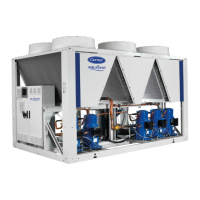13.5 - Tightening torques for the main
fastenings
Screw type Use Value (N.m)
Metal screw D=4,8
Condensing module, casing,
supports
4,2
Metal screw D = 6,3 Plastic impeller 4,2
Taptite M10 screw
Condensing module, casing-
structure, electrical box xing,
plate heat exchanger and pump
30
Taptite M6 screw Mounting pipes, enclosure 7
Oil equalisation screw Oil equalisation line 145
M6 hex screw Pipe clip 10
M10 H nut
Compressor chassis, Compressor
xing
30
13.6 - Air-cooled exchanger
We recommend that coils are inspected regularly to check the
degree of fouling. This depends on the environment where the
unit is installed, in particular urban and industrial sites, and for
units installed near trees that shed their leaves.
Recommendations for maintenance and cleaning of air-cooled
exchangers:
■ Regularly cleaning the coil surface is essential for correct unit
operation.
■ Eliminating contamination and removal of harmful residue will
increase the operating life of the coils and the unit.
■ The maintenance and cleaning procedures below are part of
the regular maintenance to increase the operating life of coils.
■ Specic recommendation in case of snow: for long term storage,
regularly check that no snow has accumulated on the coil.
Specic data for RB and RBP tted with MCHE:
■ Clean the surface of the coil by spraying the coil regularly and
uniformly from bottom to top, orienting the water jet at right
angles to the surface. Do not exceed a water pressure of 6200
kPa (62 bar) or an angle of 45° in relation to the coil. The nozzle
must be at least 300 mm away from the coil surface.
■ Clean and scrub the entire connection with a exible Nylon,
PolyPro
®
or Tynex
®
brush and low pressure tap water.
Level 1 cleaning:
■ Remove all foreign objects or debris attached to the surface of
the coil or wedged between the casing and the supports
■ For RQ and RQP tted with RTPF coils, scrub vertically and
gently using a brush.
■ Use a low pressure dry air jet to remove all traces of dust from
the coil.
Level 2 cleaning:
■ Carry out the level 1 cleaning operations.
■ Clean the coil using appropriate products.
Use appropriate PPE including safety glasses and/or mask,
waterproof clothes and safety gloves. It is recommended to
wear clothing that covers the whole body.
Specic products approved by the manufacturer for cleaning
coils are available from the manufacturer's spare parts
network. The use of any other product is strictly prohibited.
After the cleaning product is applied, rinsing with water is
mandatory (see manufacturer's standard RW01-25).
IMPORTANT:
Never use a pressure water spray without a large diuser.
Concentrated and/or rotating water jets are strictly forbidden.
Never use a uid with a temperature above 45°C to clean the
air-cooled exchangers.
Correct and frequent cleaning (approximately every three
months) will prevent two thirds of corrosion problems. Protect
the electrics box during cleaning operations.
13.7 - Water type heat exchanger
Check that:
■ The insulation has not been detached or torn during operations,
■ The heaters and probes are operating and correctly positioned
in their supports,
■ The water-side connections are clean and show no sign of
leakage,
■ The periodic inspections required by local regulations have
been carried out
13.8 - Variable frequency drive
IMPORTANT: Before any work on the variable frequency drive,
ensure that the circuit is isolated and there is no
voltage present (reminder: The capacitors take approximately
5 minutes to discharge once the circuit breaker has been
opened). Only appropriately qualified personnel are
authorised to work on the variable frequency drive.
In case of any alarm or persistent problem related to the variable
frequency drive, contact the manufacturer's service department.
The variable frequency drives tted on the units do not require a
dielectric test, even if being replaced: they are systematically
checked before delivery. Moreover, the ltering components
installed in the variable frequency drive can falsify the measurement
and may even be damaged. If there is a need to test the insulation
of a component (fan motors and pumps, cables, etc.), the variable
frequency drive must be disconnected from the power circuit.
13 - STANDARD MAINTENANCE
97

